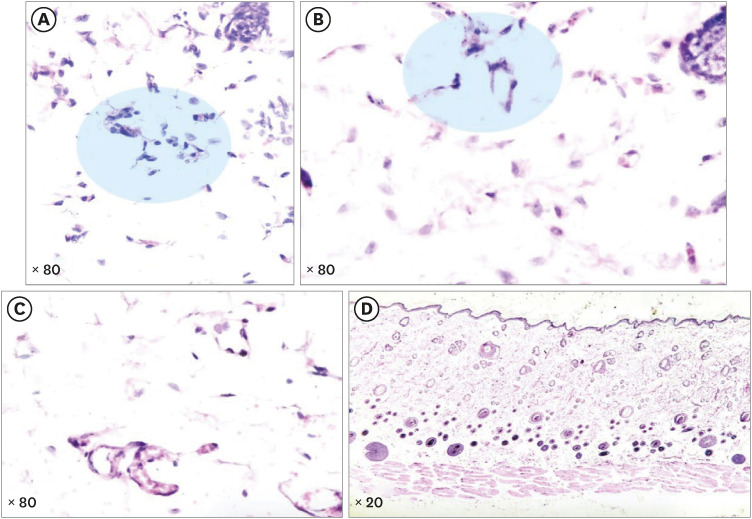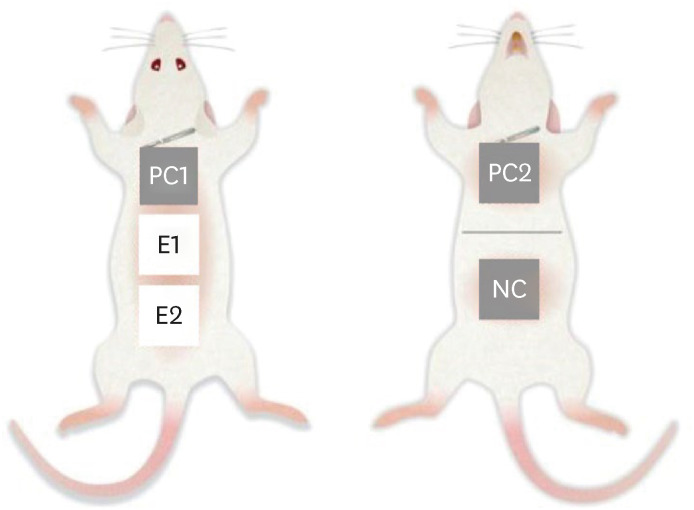1. Burgener B, Ford AR, Situ H, Fayad MI, Hao JJ, Wenckus CS, Johnson BR, BeGole EA, George A. Biologic markers for odontogenic periradicular periodontitis. J Endod. 2010; 36:1307–1310. PMID:
20647085.

2. Ricucci D, Pascon EA, Ford TR, Langeland K. Epithelium and bacteria in periapical lesions. Oral Surg Oral Med Oral Pathol Oral Radiol Endod. 2006; 101:239–249. PMID:
16448928.

3. Punchard NA, Whelan CJ, Adcock I. The
Journal of Inflammation. J Inflamm (Lond). 2004; 1:1. PMID:
15813979.
4. Krenn S, Gutwald R, Bönigk M, Krenn V. Dental Apical Inflammation Score (DAIS): histopathological scoring for the evaluation of the apical inflammatory activity and local bone destruction. Pathol Res Pract. 2020; 216:153223. PMID:
32992098.

5. Torabinejad M, Eby WC, Naidorf IJ. Inflammatory and immunological aspects of the pathogenesis of human periapical lesions. J Endod. 1985; 11:479–488. PMID:
3913729.

6. Herrera V, Wendie E. Inflamación. Rev Actual Clínica. 2014; 43:2261–2265.
7. Moore TL, Weiss TD. Mediators of inflammation. Semin Arthritis Rheum. 1985; 14:247–262. PMID:
3936177.

8. Rosenberg PA. Clinical strategies for managing endodontic pain. Endod Topics. 2002; 3:78–92.

9. Sathorn C, Parashos P, Messer H. The prevalence of postoperative pain and flare-up in single- and multiple-visit endodontic treatment: a systematic review. Int Endod J. 2008; 41:91–99. PMID:
17956561.

10. Vera J, Ochoa J, Romero M, Vazquez-Carcaño M, Ramos-Gregorio CO, Aguilar RR, Cruz A, Sleiman P, Arias A. Intracanal cryotherapy reduces postoperative pain in teeth with symptomatic apical periodontitis: a randomized multicenter clinical trial. J Endod. 2018; 44:4–8. PMID:
29079057.

11. Kowal MA. Review of physiological effects of cryotherapy. J Orthop Sports Phys Ther. 1983; 5:66–73. PMID:
18806430.

12. Vera J, Ochoa-Rivera J, Vazquez-Carcaño M, Romero M, Arias A, Sleiman P. Effect of intracanal cryotherapy on reducing root surface temperature. J Endod. 2015; 41:1884–1887. PMID:
26433855.

13. Keskin C, Özdemir Ö, Uzun İ, Güler B. Effect of intracanal cryotherapy on pain after single-visit root canal treatment. Aust Endod J. 2017; 43:83–88. PMID:
27699913.

14. Gundogdu EC, Arslan H. Effects of various cryotherapy applications on postoperative pain in molar teeth with symptomatic apical periodontitis: a preliminary randomized prospective clinical trial. J Endod. 2018; 44:349–354. PMID:
29398090.

15. Alharthi AA, Aljoudi MH, Almaliki MN, Almalki MA, Sunbul MA. Effect of intra-canal cryotherapy on post-endodontic pain in single-visit RCT: a randomized controlled trial. Saudi Dent J. 2019; 31:330–335. PMID:
31337936.

16. Ramírez K, Quesada-Yamasaki D, Fornaguera-Trias JA. A protocol to perform systemic lipopolysacharide (LPS) challenge in rats. Odovtos-Int J Dent Sc. 2019; 21:53–66.
17. Aldapa-Vega G, Pastelín-Palacios R, Isibasi A, Moreno-Eutimio MA, López-Macías C. Modulation of immune response by bacterial lipopolysaccharides. Alergia. 2016; 63:293–302. PMID:
27560917.
18. Maitra U, Deng H, Glaros T, Baker B, Capelluto DG, Li Z, Li L. Molecular mechanisms responsible for the selective and low-grade induction of proinflammatory mediators in murine macrophages by lipopolysaccharide. J Immunol. 2012; 189:1014–1023. PMID:
22706082.

19. Gao Y, You X, Liu Y, Gao F, Zhang Y, Yang J, Yang C. Induction of autophagy protects human dental pulp cells from lipopolysaccharide-induced pyroptotic cell death. Exp Ther Med. 2020; 19:2202–2210. PMID:
32104285.

20. Fayyad DM, Abdelsalam N, Hashem N. Cryotherapy: a new paradigm of treatment in endodontics. J Endod. 2020; 46:936–942. PMID:
32386857.

21. Watkins AA, Johnson TV, Shrewsberry AB, Nourparvar P, Madni T, Watkins CJ, Feingold PL, Kooby DA, Maithel SK, Staley CA, Master VA. Ice packs reduce postoperative midline incision pain and narcotic use: a randomized controlled trial. J Am Coll Surg. 2014; 219:511–517. PMID:
25081937.

22. Hubbard TJ, Denegar CR. Does cryotherapy improve outcomes with soft tissue injury? J Athl Train. 2004; 39:278–279. PMID:
15496998.
23. Nadler SF, Weingand K, Kruse RJ. The physiologic basis and clinical applications of cryotherapy and thermotherapy for the pain practitioner. Pain Physician. 2004; 7:395–399. PMID:
16858479.
24. Sadaf D, Ahmad MZ, Onakpoya IJ. Effectiveness of intracanal cryotherapy in root canal therapy: a systematic review and meta-analysis of randomized clinical trials. J Endod. 2020; 46:1811–1823.e1. PMID:
32916207.

25. Gupta A, Aggarwal V, Gurawa A, Mehta N, Abraham D, Singh A, Jala S, Chauhan N. Effect of intracanal cryotherapy on postendodontic pain: a systematic review and meta-analysis of randomized controlled trials. J Dent Anesth Pain Med. 2021; 21:15–27. PMID:
33585681.

26. Almohaimede A, Al-Madi E. Is intracanal cryotherapy effective in reducing postoperative endodontic pain? an updated systematic review and meta-analysis of randomized clinical trials. Int J Environ Res Public Health. 2021; 18:11750. PMID:
34831517.

27. Hespanhol FG, Guimarães LS, Antunes LA, Antunes LS. Effect of intracanal cryotherapy on postoperative pain after endodontic treatment: systematic review with meta-analysis. Restor Dent Endod. 2022; 47:e30. PMID:
36090511.

28. Kumari N, Kaur H, Choudhary R, Yeluri R. Comparative evaluation of intracanal cryotherapy and curcumin as a final irrigant in reducing post endodontic pain in primary teeth. J Indian Soc Pedod Prev Dent. 2022; 40:297–301. PMID:
36260471.







 PDF
PDF Citation
Citation Print
Print




 XML Download
XML Download